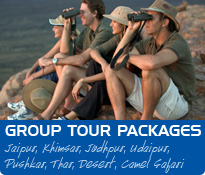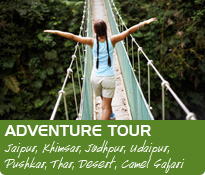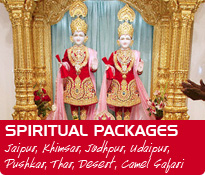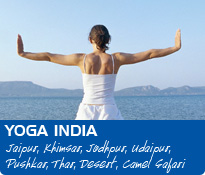India Information (About India)
Location: South Asia, Area: 3,166,414 sq km (1,222,582 sq miles), Capital: New Delhi, Government: Republic since 1947, Religion: About 81% Hindu, 12% Muslim, with Sikh, Christian, Jain, Parsi and Buddhist minorities.
In India, the main language is Hindi which is spoken by about 30% of the population; English is also enshrined in the constitution for a wide range of official purposes. In addition, 17 regional languages are recognized by the constitution. These include Bengali, Gujarati, Oriya and Punjabi which are widely used in the north, and Tamil and Telegu, which are common in the south. Other regional languages are Kannada, Malayalam and Marathi. The Muslim population largely speak Urdu. India moment of glory finally arrived on the midnight of 15 August 1947. People delirious with joy flooded the streets to welcome the dawn of a new era. There was rejoicing everywhere. And within the Assembly Hall, Jawaharlal Nehru rose to make his famous "tryst with destiny" speech. By the early hours of morning, as the clouds sent a light drizzle to acknowledge the awakening, independent India was all set to transform a colonial society into a liberal polity. Travel in India is a mixed experience that will have you going through a gamut of emotions. The people, the attitudes, the roads, the bottlenecks, the poverty, the generosity, the sences will have you smiling in delight, mulling in thought and sighing in exasperation from one minute to the other! In the the bargain what you will get is a Kaleidoscopic display of breathtaking locales, fantastic architecture, exciting and exotic wildlife, magnificent beauty of the Himalayas, and unending friendliness and hospitality of the welcoming people. The Indian sub-continent can be picturised as a rough triangle, with the top formed by the mighty Himalayan mountain chain. Here you will find the intriguing Tibet influenced region of Leh and Ladakh and the amazingly beautiful mountainous areas of Himachal Pradesh, Punjab in the North West, past the capital city of Delhi and important tourist attractions like Agra ( Taj Mahal ), Khajuraho, Varanasi and the holy Ganges, to the Northern end of the Bay of Bengal, where you will find the teeming city of Kolkata ( Calcutta ), which seems to sum up all of India's problem.The spirit of India has thus fascinated the world with its very mystique. A subcontinent with a 5000-year old history. A civilization united by its diversity - India has always been known as a land where history echoes itself with all its wonders in every piece of stone and every particle of dust. About the culture of India, every state has its own language with various dialects, its own unique cuisine that is distinctly different from that of the other states, art and craft, special fairs and festivals, teeming bazaars and customs that are peculiar to them.
All in all, travel in India is a spectrum of experiences and activities that you can choose from. From having an idyllic holiday lying under the sun on the unmatchable beaches of Goa, to undertaking a harsh yet very romantic camel safari in the deserts of Rajasthan, treeking through the wild forests of Assam or visiting the splendid royal forts and palaces, India is a "total experience" tourist destination that is sure to leave an indelible impression on your thoughts. And with us, you can be sure that you will be treated to the very best of its colorful experiences, redoubtable sites and fascinating ways of life! The majority of the inhabitants of India are Hindus, their festivals dominate the calendar. The most colorful of all the festival is Deepawali or Diwali as it is commonly known, the festival of lights. The central figure in the Indian epic, Ramayana, is Rama who went into exile for fourteen years at his father's behest, accompanied by his wife Sita and his brother Lakshman. During their wanderings in the forests, Ravana, the king of Lanka, carried Sita away. It was only after an epic battle that Rama vanquished Ravana, rescued Sita and returned home to his kingdom of Ayodhya. The journey from Lanka in the south to Ayodhya in the north took twenty days. His triumphal return to Ayodhya brought great joy to his people who illuminated the whole city to celebrate the occasion. This joy and this illumination continues to this day as houses and cities throughout the India are lit up (traditionally with small earthenware cups or diyas filled with oil) to commemorate the anniversary. Deepawli signifies the triumph of good over evil and light over darkness The battle between Ravana and Rama and the latter's victory are celebrated as Dussehra in many parts of India, twenty days before Deepawali. Dussehra is the day when the effigies of Ravana, his brothers Meghnath and Kumbhakaran, are burnt. Dussehra is preceded by enactment of the story of the Ramayana by amateur groups of people in all villages, cities and in localities of the metropolis throughout India. Practically all-night performances of the Ramayana from the beginning to the end are enacted, analogous to street plays, and the actors are mainly young boys who perform the role of the male and the female characters. Immense popularity is reflected by the large gatherings for these performances known as Ram Lila. These are simplified accounts of two of the major festivals of the Hindus in India but there are many variations and accretions as different people perform different rituals and forms of worship. For example, in Bengal, the worship of the Goddess Durga precedes Deepawali. While Goddess Durga is the eminent icon crafted with great devotion in West Bengal, Lord Ganesha - acknowledged universally in India as the remover of obstacles - who is the central figure in the celebration of Ganesh Chaturthi in Maharashtra.In India,there are about 3,000 communities in India. So wide and complex is the mix of the Indian population that two-thirds of her communities are found in the geographical boundaries of each of her states. They are a mingling of the Caucasoid, the Negrito, the Proto-Austroloids, the Mongoloid and the Mediterranean races. The tribals constitute eight percent of the total population of India. Based on their physical type and language, we can easily divide Indian people into four broad classes.
First, a majority of high class Hindus, who live in North India and whose language is derived from Sanskrit. Secondly, those who live in that part of India that is south of the Vindhyas and whose languages - Tamil, Telugu, Kannada and Malayalam - are entirely different from Sanskrit. These are known by the generic name of "Dravidians". Thirdly, primitive tribes living in hills and jungles of India, who as mentioned above constitute eight percent of the total population in India. The Kols,Bhils and Mundas belong to this class. Fourthly, there are a people with strong Mongolian features inhabiting within India the slopes of the Himalayas and the northeastern states. India's newly acquired status as a nuclear power and a booming economy has thus brought under international limelight. Its internal problems notwithstanding, India has stepped into the new millennium with great confidence. India therefore can be defined as a land where humanity has lived since ages; where different religions, societies, cultures, languages have interplayed with each other in harmony; a land which has seen the best and the worst of everything; a land where religion means more than their name. East or West India is the best.












